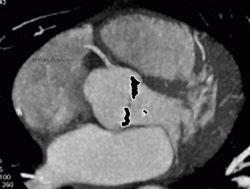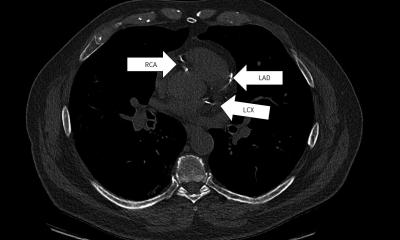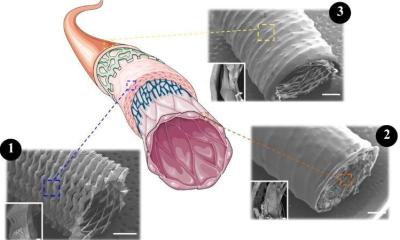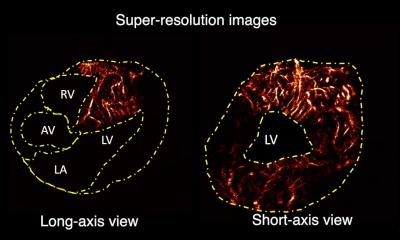Genetic variation doubles risk of aortic valve calcification
Study described in The New England Journal of Medicine is the first to show cause-and-effect relationship between a gene variant and calcium deposits on the aortic valve.

Researchers have found a genetic variant that doubles the likelihood that people will have calcium deposits on their aortic valve. Such calcification, if it becomes severe, can cause narrowing or a blockage of the aortic valve, a condition called aortic stenosis. The study is the first large-scale, genome-wide association study to uncover a genetic link to aortic valve calcification. An article detailing the findings is published in the February 7, 2013 issue of The New England Journal of Medicine.
The study’s lead investigators — from Johns Hopkins, Harvard University, McGill University, the University of Iceland and the National Institutes of Health — found that having a genetic variant in the LPA gene, which codes for a type of cholesterol particle called lipoprotein (a), also increases the risk of developing aortic stenosis by more than 50 percent.
The researchers say their findings not only help explain why heart valve calcification may run in families, they could also lead to the development of targeted medications that might slow the progression of the disease. Statin medications, which reduce common forms of cholesterol that can clog blood vessels, have not been shown to reduce aortic valve calcification.
“This is an important step forward in understanding the biology of the development of aortic stenosis and how this common genetic variant, which is found in 7 percent of the general population, contributes to that risk,” says Wendy Post, M.D., a cardiologist and associate professor of medicine and epidemiology at the Johns Hopkins University School of Medicine who is a senior author of the study.
Non-genetic risk factors for aortic valve calcification include advancing age, high blood pressure, obesity, high cholesterol levels and smoking. Men are at higher risk than women.
In the study, the researchers first looked at 2.5 million gene variants, called single nucleotide polymorphisms or SNPs, among more than 6,900 people of white European background, and found that this variant in the LPA gene was strongly associated with having aortic valve calcification on a heart CT scan, according to lead author Catherine Campbell, M.D., formerly the chief cardiology fellow at Johns Hopkins who now works for Kaiser Permanente.
Lipoprotein (a) is an unusual type of cholesterol particle that circulates in the blood and is associated with an increased risk for heart attacks.
“Increased levels of lipoprotein (a) have been previously associated with aortic valve disease. However, prior studies could not differentiate whether it was simply a marker or a causal factor,” says Campbell. “Our results provide the first evidence for a causal relationship between lipoprotein (a) and calcific aortic valve disease,” she adds.
Once the researchers identified the association between the LPA gene variant and those with evidence of aortic valve calcium in that first group, they confirmed their findings among three other groups — more than 2,000 people of Hispanic origin, about 2,500 African-Americans and more than 700 Germans. The people in those three groups, as well as the initial 6,900 Caucasians, were participants in several ongoing studies — the Multi-Ethnic Study of Atherosclerosis (MESA); the Framingham Heart Study; the Age, Gene/Environment Susceptibility (AGES) study in Iceland; and the Heinz Nixdorf Recall study in Germany. All had previously undergone a CT scan to look for the presence of aortic valve calcium.
The researchers also were able to demonstrate an association between the LPA gene variant and the future development of clinical aortic stenosis in two independent groups — more than 28,000 research participants in Sweden and more than 10,000 participants in Denmark.
Aortic stenosis, when calcified plaque causes narrowing in the aortic valve, can cause chest pain, loss of consciousness and shortness of breath. In severe cases, patients may need aortic valve replacement surgery. More than 1 million individuals in the United States have aortic stenosis, making it the most common form of valve disease.
“Advancing age is a major risk factor for aortic stenosis and with the aging of the population, this will become an even bigger health concern,” says Post. “We believe our findings will help us better understand the biology of how valve calcification develops and open the door to new avenues of therapy, possibly with medicines that lower lipoprotein (a) levels in the blood,” she says.
The study was funded by multiple grants through the National Heart, Lung, and Blood Institute as well as other funding agencies.
FUNDING DETAILS:
The Framingham Heart Study was supported by the National Heart, Lung, and Blood Institute (NHLBI) (N01-HC-25195) and an NHLBI contract with Affymetrix, Inc. for genotyping services (N02-HL-6-4278). The Age, Gene/Environment Susceptibility-Reykjavik Study was supported by the National Institute on Aging (N01-AG-12100), the National Eye Institute, the National Institute on Deafness and Other Communication Disorders, the NHLBI, the National Institute on Aging’s Intramural Research Program, Hjartavernd (the Icelandic Heart Association), and the Althingi (Icelandic Parliament). MESA, MESA Family, MESA CARe, and the MESA SHARe project were supported by the NHLBI (N01-HC-95159 through 95169, RR-024156, R01-HL-071739, R01-HL-071051, R01-HL-071205, R01-HL-071250, R01-HL-071251, R01-HL-071252, R01-HL-071258, and R01-HL-071259, N02-HL-6-4278, N01-HC-65226). The Heinz Nixdorf Recall Study was supported by the Heinz Nixdorf Foundation and the German Research Foundation (DFG). The Malmö Diet and Cancer study was supported by the Swedish Cancer Society, the Swedish Medical Research Council, the Swedish Dairy Association, the Albert Påhlsson and Gunnar Nilsson Foundations, and the Malmö city council. CCHS was supported by the Danish Heart Foundation.
05.02.2013











